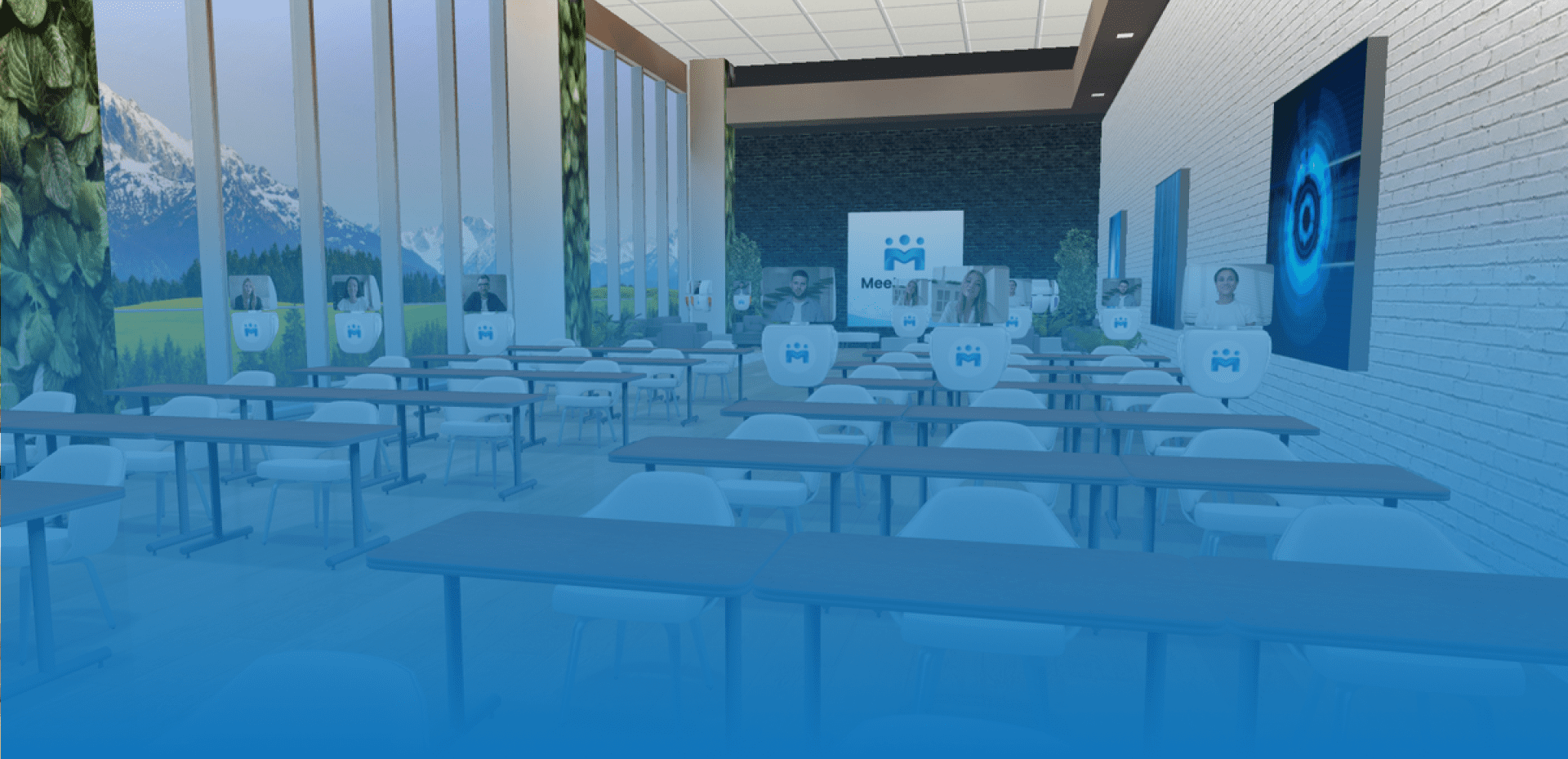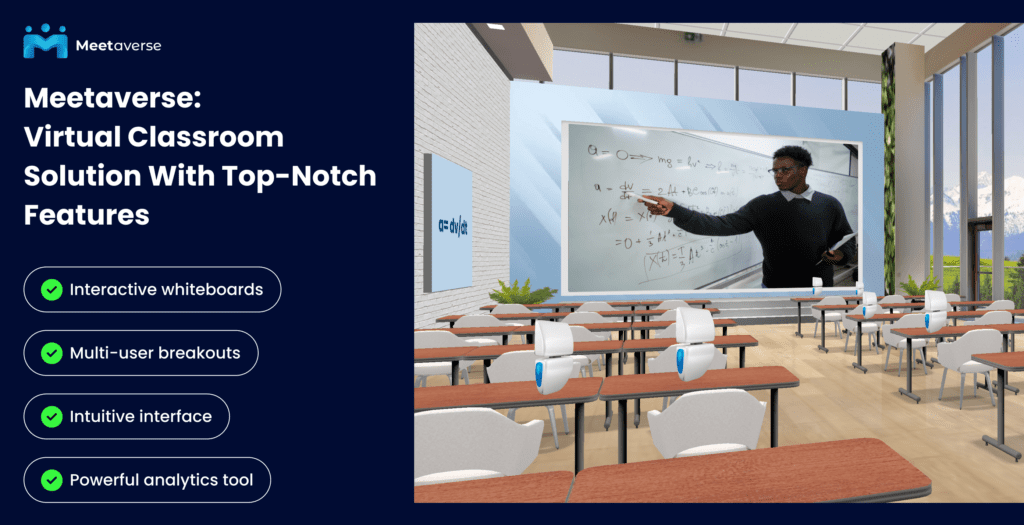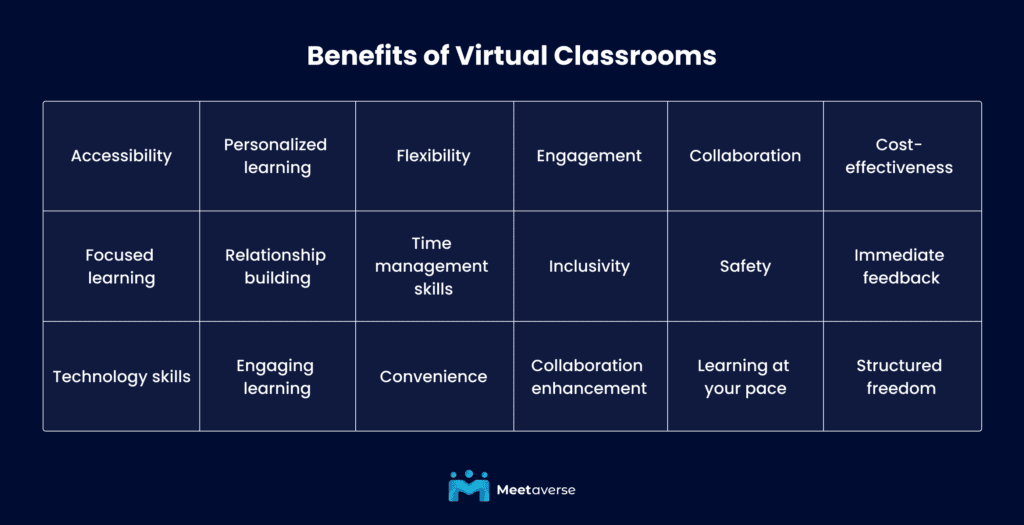
Step into the future of education with the online virtual classroom – an exciting space where universities and immersive learning collide. Think of it as a digital hub where students and teachers connect, creating a cool mix of tech and education. In this article, we’ll dive into this special tool, exploring how it’s shaking up higher education and making learning super exciting.
Get ready for a journey into understanding the virtual classroom meaning!

Virtual classroom is an online learning environment replicating a traditional classroom’s interactive experience, but without physical boundaries. It leverages education technology to connect students and instructors from anywhere in the world, fostering real-time student engagement and collaboration through interactive tools and shared learning materials.
In order to ensure the effective functioning of a virtual classroom and maximize its impact on online learning, it is essential to incorporate specific features. These features play a crucial role in replicating the traditional classroom experience in a digital environment, fostering student engagement and creating a dynamic learning space.
A virtual classroom platform is the digital foundation that supports distance learning. It serves as the virtual space where teachers conduct classes and students engage in learning activities. This platform integrates various tools and features to replicate the traditional classroom experience in an online environment.
Virtual classrooms provide flexibility through both synchronous and asynchronous learning options. Synchronous learning occurs in real time, enabling live interaction between teachers and students. On the other hand, asynchronous learning allows students to access recorded lectures and materials at their convenience, fostering self-paced learning.
Interactivity is a key component of a virtual classroom learning. Interactive features include live chat, discussion forums, and collaborative tools that facilitate engagement and create a sense of community among students. Additional tools like interactive whiteboards, polls, and breakout rooms enhance the learning experience, making online virtual classrooms dynamic and participatory.
Video conferencing is a fundamental technology for interactive virtual classrooms, enabling real-time communication between educators and students. It brings traditional classrooms’ visual and auditory elements to the digital realm, allowing for face-to-face interaction regardless of physical location.
Collaboration tools are essential for fostering teamwork and interaction in online virtual classrooms. These tools include shared documents, group projects, and collaborative editing features, enabling students to work together seamlessly and enhance the overall learning experience.
Learning Management Systems (LMS) play a crucial role in the organization and delivery of educational content. LMS integration allows for the seamless management of courses, assignments, and assessments. It provides a centralized platform for tracking student progress, facilitating communication, and streamlining the overall educational process within the virtual classroom.
Before embarking on your online lesson, check how to create a virtual classroom, ensure you have all the necessary tools and technology downloaded and prepared, including audio and video inputs and virtual classroom interfaces.
For students:
For teachers:
Looking for a new and revolutionary L&D solution?
Leave your contact information and a Meetaverse professional will be happy to tell you more about how we can help
Meetaverse goes above and beyond as a user-friendly virtual classroom solution, bringing clarity and engagement to online learning. With high-quality video communication, students can feel present in the virtual classroom, and interactive tools make participation easy and enjoyable. It fosters vibrant digital spaces where students and instructors connect regardless of location, empowering everyone with the tools to thrive in this new learning environment.
Key features for dynamic learning:

Even if you are against all new technologies, you cannot deny these advantages of virtual classrooms:

While the concept of virtual classrooms offers a wealth of benefits, it’s important to acknowledge the potential drawbacks they can present. Here are a few key disadvantages to consider:
Remember, these disadvantages can be mitigated with careful planning, effective strategies, and a commitment to continuous improvement within virtual classroom environments.
The education landscape is evolving, and virtual classroom online learning is challenging the traditional brick-and-mortar model. While both settings offer learning opportunities, understanding their differences is crucial for choosing the right fit. Let’s compare virtual classroom vs traditional classroom:
| Real classrooms | Virtual classrooms | |
| Learning outcomes | – Immediate feedback; – Face-to-face interaction; – Hands-on experiences. |
– Personalized learning paths; – Diverse resources; – Knowledge retention; – Self-directed learning. |
| Student engagement | – Active participation; – Peer-to-peer learning; – Intrinsic motivation. |
– Interactive features; – Gamification; – Collaborative tools; – Potential for distractions. |
| Skills development | – Teamwork; – Communication; – Leadership; – Social interaction. |
– Time management; – Self-discipline; – Technology skills; – Requires additional support for social and communication skills. |
In the shift towards digital education, virtual classrooms introduce distinct challenges that necessitate innovative solutions for effective learning and student support. Three main challenges are:
To overcome isolation, the design of virtual classrooms incorporates:
To effectively manage the reliance on technology in virtual learning environments, the following strategies offer a balanced and comprehensive approach:
To address the unique challenge of evaluating students in virtual environments, educators are turning to the following innovative solutions:
As virtual classrooms continue to evolve, proactive measures are being taken to address these concerns, leading to a more effective and inclusive educational environment.
Studies and Success Stories:
The educational landscape is experiencing a significant shift, with virtual students’ digital classrooms emerging as a powerful force shaping university learning and online education. Driven by factors like the post-pandemic surge in remote learning preferences and the global reach they offer, virtual classrooms integrations are poised to play a critical role in the future of education.
The COVID-19 pandemic undeniably propelled online learning into the mainstream. Students and educators alike discovered the benefits of online education in a virtual classroom such as flexibility, accessibility, and convenience. Now, even as physical classrooms reopen, there’s a sustained demand for remote learning options. A study by McKinsey & Company revealed that 70% of global learners prefer hybrid or online learning models, highlighting the enduring impact of the pandemic and the changing preferences of today’s learners.

Recognizing this shift, universities worldwide actively leverage virtual classroom benefits to expand their academic offerings and cater to diverse learning needs. They’re employing virtual platforms to deliver everything from traditional undergraduate programs to specialized courses and even MOOCs (Massive Open Online Courses), reaching a wider audience than ever before.
One of the most significant virtual classroom advantages is their ability to break down geographical barriers. Students from remote locations, working professionals, and individuals with disabilities can now access high-quality education opportunities irrespective of their physical constraints. This enhances the inclusivity and accessibility of higher education, opening doors for a wider and more diverse student population.
For universities, virtual classroom video conferencing offers significant cost-saving opportunities. Reduced infrastructure and overhead expenses translate into the ability to offer wider course options and cater to larger student populations without incurring massive physical resource investments. Additionally, the scalability of virtual classroom platforms allows universities to easily adapt their offerings to meet fluctuating student demand.
Modern characteristics of virtual classroom platforms seamlessly integrate with existing university learning management systems (LMS), ensuring a smooth workflow for both students and instructors. Additionally, these platforms collect rich data on student engagement, learning patterns, and performance. This data-driven approach empowers universities to tailor their virtual courses and improve the overall learning experience.
While virtual worlds in the classrooms offer immense potential, it’s important to acknowledge that they may not replace traditional in-person learning completely. The ideal approach lies in a blended learning model, where virtual and real classrooms complement each other. By embracing virtual solutions strategically and addressing potential challenges like technology access and social interaction, universities should understand how effective is virtual classrooms. They cater to the evolving needs of students and ensure a vibrant, accessible, and future-proof learning environment.
In conclusion, the year 2024 marks a pivotal moment for virtual classrooms in universities and online education. Driven by increasing demand, enhanced accessibility, and cost-effective solutions, they are poised to revolutionize the way we learn and teach. By embracing this transformation and integrating the meaning of virtual classrooms thoughtfully, universities can unlock a world of possibilities for a diverse and empowered student body, shaping the future of education for generations to come.
Universities should explore the vast possibilities offered by virtual classrooms, considering the advantages and disadvantages. To harness these opportunities, consider incorporating Meetaverse, a platform that opens up a world of possibilities for immersive and interactive virtual learning experiences. To explore the potential firsthand, you can book a demo here.
Looking for a new and revolutionary L&D solution?
Leave your contact information and a Meetaverse professional will be happy to tell you more about how we can help
An online virtual classroom is a digital learning environment hosted on a web platform. It allows students and instructors to connect, interact, and participate in educational activities in real-time, regardless of their physical location. Think of it as a digital replica of a traditional classroom, with features like video conferencing, interactive whiteboards, collaborative tools, and more.
Popular examples of virtual classrooms include Meetaverse, Zoom, Google Meet, Blackboard Collaborate, Adobe Connect, and specialized platforms like Nearpod and Edmodo. Universities and schools often use their own learning management systems (LMS) with integrated virtual classroom functionalities.
First of all, make sure you have all of the equipments required for virtual classroom. Students typically access the virtual classroom through a web browser or dedicated app. Once logged in, they can see and hear the instructor and other students in real-time. Instructors can share presentations, whiteboard content, polls, and other resources, while students can interact through chat, raise hands, and participate in collaborative activities.
Everyone always compares virtual vs real classrooms. While both have their advantages, virtual classrooms offer unique benefits like flexibility, accessibility, and personalized learning. However, it’s not necessarily “better” than a real classroom; the ideal approach often lies in a blended learning model that combines the strengths of both in-person and online learning.
Remember, virtual classrooms are a powerful tool for education, but there are also limitations of virtual classrooms. Choosing the right learning environment depends on individual needs, learning styles, and the specific course requirements.
The landscape of education is evolving, and universities are embracing the power...
read moreIn the world of education, keeping up with tech changes is vital for a dynamic l...
read moreThe digital revolution has completely transformed our lives, and education is no...
read more

